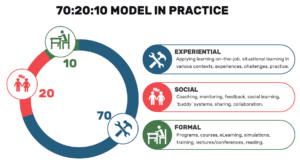Scenario-Based Learning: Crafting Realistic Simulations for Skill Development
This powerful approach puts learners in the driver’s seat, letting them navigate real-world challenges in a safe, engaging environment. Let’s explore how you can craft scenarios that don’t just teach – they transform.
The Power of “What If?”
Scenario-based learning isn’t just another buzzword – it’s a game-changer. By immersing learners in realistic situations, you’re not just feeding them information; you’re helping them develop critical thinking skills, decision-making abilities, and problem-solving skills. As Clark and Mayer (2016) point out, “Scenarios tap into the human love of stories and challenge learners to apply new skills in context” (p. 223).
But the benefits don’t stop there. Scenario-based learning also:

Boosts engagement
Learners are active participants, not passive observers

Enhances retention
Learners are active participants, not passive observers

Builds confidence
Learners can practice in a low-stakes environment before facing real-world challenges.

Provides immediate feedback
Learners see the consequences of their choices in real-time.
Flexing your scenario muscles
Scenario-based learning isn’t a one-trick pony. You can flex this approach in various ways throughout your learning designs:
- As an attention-grabbing opener: Kick off your course with a scenario that highlights why the content matters.
- To introduce new concepts: Present a challenge, then guide learners through the solution, introducing key ideas along the way.
- For application practice: After teaching a concept, let learners apply it in a realistic scenario.
- As a comprehensive assessment: Evaluate learners’ ability to synthesise and apply multiple concepts in a complex scenario.
- For spaced repetition: Revisit key concepts through different scenarios throughout the course.
Whether you’re designing for eLearning or face-to-face environments, scenarios can add depth and relevance to your content. In eLearning, you might create branching scenarios where learners’ choices determine the outcome. In face-to-face settings, you could use role-playing exercises or group discussions centered around a shared scenario.
Crafting compelling scenarios: Your step-by-step guide
Ready to create scenarios that sizzle? Follow these steps:
- Align with learning objectives: Every scenario should directly support your course goals. Don’t get carried away with an exciting story that doesn’t serve your learning outcomes.
- Know your audience: Tailor your scenarios to your learners’ experience level and job roles. A scenario for entry-level employees will look different from one for seasoned managers.
- Partner with Subject Matter Experts (SMEs): Work closely with SMEs to ensure your scenarios are realistic and nuanced. As Dirksen (2016) notes, “SMEs can provide the details that make a scenario feel authentic” (p. 147).
- Set the stage: Provide enough context for learners to understand their role and the situation. But don’t overdo it – leave room for critical thinking.
- Create challenges and decision points: Design situations where learners must apply their knowledge to make choices. Ensure these decision points are realistic and relevant.
- Develop consequences: Every choice should have a logical outcome. This is where the learning happens! As Pappas (2014) suggests, “Allow learners to see how their decisions impact the outcome of the scenario” (para. 7).
- Provide feedback: Don’t just tell learners if they’re right or wrong. Offer detailed feedback that explains the consequences of their choices and guides them towards better decisions. Better yet, write the consequence as a story that continues the narrative.
- Add emotional elements: Real-life situations often involve interpersonal dynamics and emotional factors. Include these to make your scenarios more authentic and engaging.
- Consider branching: For more complex topics, create branching scenarios where one decision leads to a new set of challenges.
- Test and refine: Pilot your scenarios with a sample group. Use their feedback to fine-tune and improve.
Pro tips for scenario superstars
Want to take your scenarios from good to great? Try these tips:
- Keep it relevant: Ensure your scenarios reflect situations learners are likely to encounter in their real jobs.
- Embrace ambiguity: Real life isn’t always black and white. Include some gray areas to really challenge your learners.
- Use multimedia: Enhance your scenarios with images, videos, or audio to make them more immersive.
- Provide resources: Give learners access to relevant information they might need to make decisions, just like they’d have in real life.
- Encourage reflection: After completing a scenario, prompt learners to reflect on their choices and what they’ve learned.
- Vary the complexity: Start with simpler scenarios and gradually increase the difficulty as learners progress.
- Create a story arc: Link multiple scenarios together to create a larger narrative that unfolds throughout the course.
- Use authentic language: Make dialogue and descriptions sound natural, not like a textbook.
- Include time pressure: Add a sense of urgency to some scenarios to simulate real-world time constraints.
- Offer multiple paths to success: In many real-life situations, there’s more than one way to succeed. Reflect this in your scenarios when appropriate.
- Craft consequences as continuing narratives: Don’t just tell learners the outcome of their choices – show them. Write the consequence as a continuation of the story. This approach maintains immersion and helps learners see how their decisions play out in a realistic context. For example, if a learner chooses to address a team conflict directly, don’t just say “Good choice!” Instead, continue the narrative: “As you address the issue head-on in your team meeting, you notice Tom’s defensive posture softening. By the end of the discussion, the team has agreed on a new communication protocol…”
Frame choices as dialogue in conversational scenarios: When writing scenarios as scripts or dialogues, present the learner’s choices as potential responses within the conversation. This technique makes the interaction feel more natural and helps learners envision themselves in the situation. Instead of generic options like “A. Agree, B. Disagree, C. Ask for more information,” try dialogue-based choices:
A. “I see your point, Sarah. Let’s move forward with your suggestion.”
B. “I’m not sure I agree. Can you help me understand your reasoning?”
C. “That’s an interesting perspective. Before we decide, what do others think?”
These tips further enhance the realism and engagement of your scenarios, making the learning experience even more immersive and effective. They help bridge the gap between theoretical learning and practical application, allowing learners to truly step into the shoes of the characters in your scenarios.
Wrapping up
Scenario-based learning is a powerful tool for transforming information into applicable skills. By crafting realistic, engaging scenarios, you’re not just teaching; you’re preparing learners for real-world success.
So, are you ready to create scenarios that will have your learners on the edge of their seats? Remember, the key is to keep it real, keep it relevant, and always tie it back to your learning objectives.
References:
Clark, R. C., & Mayer, R. E. (2016). E-learning and the science of instruction: Proven guidelines for consumers and designers of multimedia learning. John Wiley & Sons.
Dirksen, J. (2016). Design for how people learn. New Riders.
Pappas, C. (2014). 6 Steps To Create Effective Scenarios In e-Learning. eLearning Industry. https://elearningindustry.com/6-steps-create-effective-scenarios-in-e-learning
Related articles



Bloom’s Taxonomy: A Guide for Creating Effective Learning Outcomes
Merrill’s Instructional Design Principles
The 70:20:10 Learning Model
